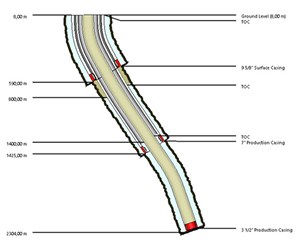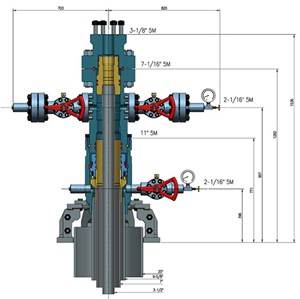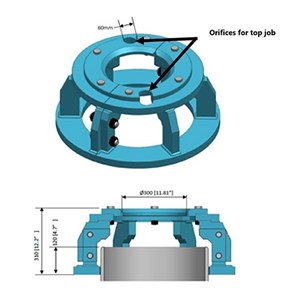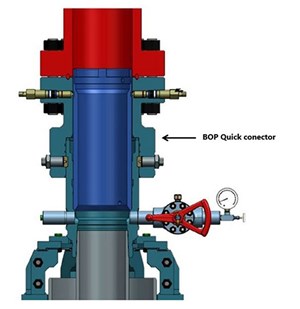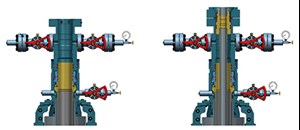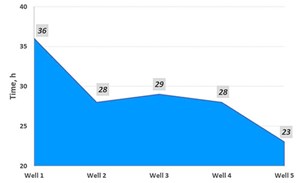Driven by the identification of new business ventures to supply energy for the northernmost areas of Brazil, and the success of the reservoir-to-wire (R2W) production and power generation model in the Parnaiba basin since October 2019, Eneva S.A. is expanding its onshore drilling operations. The company also holds a concession of several exploratory blocks in the Amazon basin and operates Azulão field, which started commercial production in September 2021.
The operational success of Azulão field was greatly influenced by leveraging the technical and economic advantages of slim monobore wells, a technique pioneered by Eneva in the Parnaiba basin during late 2016. Using monobore wells, Eneva implemented a significant step-change to monetize gas production, attaining levels of operational performance and efficiency not previously seen in the Brazilian onshore landscape.
During the 2021-2022 well campaign in the Amazon basin, one of the key technologies deployed by Eneva was a semi-compact wellhead system. The authors will describe the key design features of the equipment and results of the first installations for land well operations in Brazil.
Opportunity identification. Following a period with difficult and budget-constrained market conditions, the outlook for the onshore Brazilian oil and gas market is poised to capitalize on new growth opportunities, an appealing shift for both operating and service companies. And to remain competitive, it will be critical for companies to pursue new performance benchmarks and efficiencies by leveraging innovative technologies and cost optimization measures.
Foreseeing the potential increase of well construction activities in the Amazon basin, a service company (Web Nordeste, or Web NE) worked closely with Eneva to introduce a new 5k-rated wellhead system for a 3-hole section monobore well. It’s not the fully compact wellhead system that has been broadly used by the industry to date. The updated version is slimmer and more cost-effective. Known as the RTO3 (Portuguese acronym for “operational time reduction”), the wellhead was to be field-tested initially in four wells to measure the cost efficiency gains against a conventional spooled wellhead system that was also in use during the campaign.
In addition, the collaboration between both companies was to serve to transfer knowledge, so that Eneva’s wellsite personnel could learn operational complexities and safely execute the installation of the RTO3 with minimum technical support.
Design and development of the RTO3 technology. The monobore well architecture used by the Eneva consists of three hole sections, Fig. 1. Given the constraints of the surface location (imposed by the remoteness and unique landscape of the area), the wells are drilled directionally, ending with a soft “S” profile in the 6 1/8-in. production hole section, which is naturally promoted by known formational tendencies throughout the area. Figure 2 shows the RTO3 wellhead stack-up components for monobore wells, which are: 1) the landing base plate; 2) the 11-in. main wellhead housing; and 3) the 7 1/16-in. tubing head spool.
Top hole activities. Once the 12¼-in. hole section is completed, the 20-in. conductor extension and flowline are removed, and the conductor pipe is cut approximately 5 ft above the cellar base. Then, a two-segment landing base plate is pre-set, Fig. 3. However, it remains in an unlocked position while running the 9 5/8-in.surface casing to avoid unnecessary interference with the upper 12-in. opening when passing through with the casing centralizers.
To execute a safer operation, prior preparation is necessary. The 11-in. main wellhead housing, featuring a lower buttress threaded (BTC) box connection, is made up to the uppermost 9 5/8-in. joint of the “as installed” running tally. Similarly, the wellhead housing running tool (RT) is made up to the 9 5/8-in. landing joint. Afterwards, the RT is made up to the wellhead housing, and both connections are torqued together. There is no interference with the landing joint to RT connection, itself, because the latter features a left-hand ACME connection secured by a torque ring (which is removed after tightening up the landing joint). Lastly, both joints are broken down at the left-hand RT connection and laid down back to the pipe rack.
With the casing string close to bottom, the landing joint is connected back to the wellhead housing, the rig crew locks the landing base plate in place against the conductor, and the casing string is landed, Fig. 4 (left). Both a 2-in. LP bull plug and a gate valve are connected to the side ports, and fluids returns from the cementing job are taken directly to the cellar. The upper plate has a couple of 2-in. orifices to permit passage of macaroni pipe, should it become necessary to perform a top job.
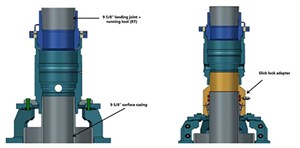
In addition, the RTO3 has an emergency mechanism, in case the surface casing fails to reach bottom, Fig. 4 (right). For this contingency, after cementing the casing and wait on cement (WOC) time, a 9 5/8-in. slip lock adapter is made up to the wellhead housing lower BTC connection, landed against the base plate, pressure-tested and secured accordingly.
A separate 11-in. top flange quick connector is used to connect to the rig’s BOP stack, Fig. 5. This component is connected to the BOP off the critical path and has a lower connection with lockdown screws to secure it against the RTO3 wellhead housing. And, since the BOP is also function- and pressure-tested off the critical path, the wear bushing can be set immediately and locked in position before nippling up the BOP/quick connector assembly.
Intermediate hole activities. Once drilling of the 8½-in. hole section is completed, some prior preparation of wellhead components is necessary. First, the mandrel-type casing hanger, with a lower BTC box connection, is made up to the uppermost 7-in. joint of the “as installed” running tally. Similarly, the casing hanger running tool (CHRT) is made up to the 7-in. landing joint, Fig. 6 (left) A torque tool is placed above the casing hanger, and the RT landing joint is made up to it, and both connections are torqued to specifications. There is no interference with the landing joint to the RT connection, itself, because the latter features a left-hand ACME connection, secured by the torque tool, which is removed after making up the landing joint.
Lastly, both joints are broken down at the left-hand RT connection and laid down back to the pipe rack. With the casing string close to bottom, the landing joint is connected back to the casing hanger and landed in the main wellhead housing. Enough rat hole is planned to permit a safe landing of the 7-in. casing.
Once the CHRT is retrieved, the next step is to set the 11-in. casing hanger pack off, Fig. 6 (center). Similar procedures to those applied for compact wellhead equipment are used, including washing the pack-off setting area and setting the pack-off, using its dedicated running tool on a stand of 5-in. heavy-walled drill pipe. As a contingency, should the 7-in. casing fail to reach the intended setting depth, after cementing and WOC, the RTO3 offers the alternative to set the casing, using a slip-type casing hanger, Fig. 6 (right). The next step is to install the tubing head spool (THS), which features a 7 1/16-in. 5k top flanged connection. The THS lands inside the 11-in. main wellhead housing and is secured in place by tightening retention nuts, Fig. 7 (left).
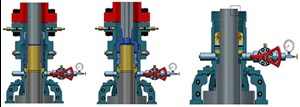
Production hole activities. One wellhead-related design aspect of Eneva’s monobore wells is the need to install the 7 1/16-in. THS prior to drilling the 6 1/8-in. production hole section. As such, Web NE had to also manufacture both a suitable wear bushing and a running/retrieving tool. Once the open hole logging program is completed, the next step is to case with 3½-in. production tubing and cement it in place, Fig. 7 (right). Other than accounting for the installation of a surface-controlled subsurface safety valve, wellhead-related activities, up to the installation of the x-mas tree, are conventional.
Implementation and results. When compared to a conventional spooled wellhead, the key time reductions brought by the RTO3 semi-compact wellhead system are mainly associated with the elimination of the wait-on-cement (WOC) time after 7-in. casing operations, manual activities at cellar level (i.e., setting the casing on slips, cut/bevel the stub–thus, reducing personnel exposure and promoting a safer operation), and the agility with BOP activities, using the quick adapter.
Figure 8 depicts the time per well for wellhead and BOP-related activities. Starting from Well 2, four consecutive installations of the RTO3 were completed, resulting in an average time reduction of approximately 9 hrs, when compared to the conventional spooled wellhead used in Well 1, which was available from the existing stock of materials. The time reduction was sufficient to offset the initial higher cost of the RTO3 (27%).
For future installations, the team will implement some additional measures for better equipment readiness. For example, during equipment preparation, Web NE will deliver all RTO3 wellhead housings and mandrel-type casing hangers fully made up to their respective casing joints, as well as to provide two sets of running tools for each component, already made up to a custom-length landing joint, Fig. 9. These measures will cut an additional four to five hours of rig time per well.
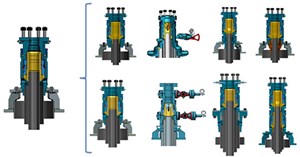
Opportunities and path forward. Eneva has embraced the technical and logistical challenges of the Amazon basin by bringing fit-for-purpose technologies and operational efficiencies. Relevant well construction-related optimizations will remain the keystone to further promote the growth and value of its R2W model across the northernmost areas of Brazil.
From the outset, development of the semi-compact RTO3 wellhead system was a collaborative effort between the operator and Web NE, ultimately resulting in cost reductions that justify its deployment as the default wellhead system for monobore wells. As such, a new contractual agreement was signed to expand the scope of supply throughout the 2023 wells campaign.
This success case has certainly caught the eye of other players in the local onshore industry. As a result, the Web NE RTO3 concept started evolving into a fully configurable system to cater to other well architectures and applications, thus paving the way for its widespread utilization.


- Shale technology: Bayesian variable pressure decline-curve analysis for shale gas wells (March 2024)
- U.S. oil and natural gas production hits record highs (February 2024)
- When electric meets intelligence: Powering a new era in hydraulic fracturing (January 2024)
- Next-generation electric fracturing system improves efficiency, ESG performance (January 2024)
- Going global with unconventionals (December 2023)
- Singlet oxygen-generating treatment technology achieves sustainable operations, helps operators meet production goals (November 2023)

